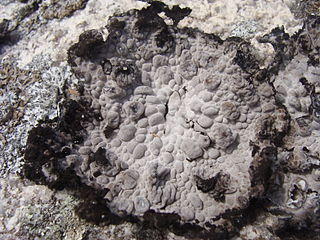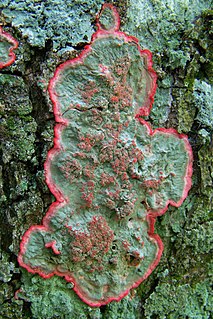
Ethnolichenology is the study of the relationship between lichens and people. Lichens have and are being used for many different purposes by human cultures across the world. The most common human use of lichens is for dye, but they have also been used for medicine, food and other purposes.

Umbilicaria esculenta is a lichen of the genus Umbilicaria that grows on rocks, also known as rock tripe. It can be found in East Asia including in China, Japan, and Korea. It is edible when properly prepared and has been used as a food source and medicine. It is called iwatake in Japanese and seogi or seogi beoseot in Korean. The species name is based on the earlier basionym Gyrophora esculenta.

Umbilicaria mammulata, or smooth rock tripe, is a foliose lichen found on boulders and rock walls.

Lasallia is a genus of lichenized fungi in the family Umbilicariaceae.

Cetrelia is a genus of leafy lichens in the large family Parmeliaceae. They are commonly known as sea-storm lichens, alluding to the wavy appearance of their lobes. The name of the genus, circumscribed in 1968 by the husband and wife lichenologists William and Chicita Culberson, alludes to the former placement of these species in the genera Cetraria and Parmelia.
Chicita Frances Culberson is an American lichenologist.

Cryptothecia rubrocincta is a species of lichen in the fungal family Arthoniaceae. The species is distributed in subtropical and tropical locations throughout the southeastern United States, as well as Central and South America, and has been collected infrequently in a few locales in Africa. The body of the lichen forms continuous, circular crust-like patches on dead wood, readily recognizable by the prominent red pigment. The older, central region is covered with red, spherical to cylindrical granules. Moving outwards from the center, zones of color may be distinguished, the first gray-green, the second white, and finally a bright red cottony rim. The red and green colors of this unmistakable woodland lichen give the appearance of a Christmas wreath, suggestive of its common North American name, the Christmas (wreath) lichen. The red pigment, called chiodectonic acid, is one of several chemicals the lichen produces to help tolerate inhospitable growing conditions.

Menegazzia terebrata is a species of foliose lichen found scattered across many continents, including North America, South America, Europe, Africa, and Asia.

Gyrophoric acid is a depside that can be found in the lichen Cryptothecia rubrocincta and in Xanthoparmelia pokomyi. It can also be found in most of the species of the Actinogyra, Lasallia, and Umbilicaria genera.

William Louis "Bill" Culberson was an American lichenologist.

Lecanoric acid is a chemical produced by several species of lichen. Lecanoric acid is classified as a polyphenol and a didepside and it functions as an antioxidant. The acid is named after the lichen Lecanora. The acid has also been isolated from Usnea subvacata, Parmotrema stuppuem, Parmotrema tinctorum and Parmotrema grayana. A related compound, 5-chlorolecanoric acid, is found in some species of Punctelia.
Emanuel David "Rudy" Rudolph was a botanist, lichenologist, and historian of botany. He was "the first botanist to conduct diverse experiments on the total biology of lichens in both polar regions".

Umbilicaria hyperborea, commonly known as blistered rock tripe, is a species of foliose lichen in the family Umbilicariaceae. It is widely distributed in arctic and alpine regions.

Punctelia hypoleucites, commonly known as the southwestern speckled shield lichen, is a species of foliose (leafy) lichen in the family Parmeliaceae. First formally described by Finnish botanist William Nylander as a species of Parmelia, it was transferred to the genus Punctelia in 1982. The lichen is found in Africa, North America, and South America, where it grows on the bark of both hardwood and coniferous trees. Its greenish-grey thallus is covered with tiny white pseudocyphellae – minute holes in the thallus surface that facilitate gas exchange. Some macroscopic features that help distinguish this species from other related members of the genus include the presence and the structure of the apothecia, the absence of asexual surface propagules, and the light brown color of the thallus undersurface. Chemically, the presence of lecanoric acid in the medulla and atranorin in the cortex help distinguish it from lookalikes.

Punctelia graminicola is a species of foliose (leafy) lichen in the family Parmeliaceae. It grows on rocks, and, less frequently, on bark in North America, South America, and East Africa. It has a blue-grey thallus measuring up to about 15 cm (6 in), covered with tiny pores called pseudocyphellae. Sometimes the lichen forms small lobes that project out from the surface. Fruiting bodies are uncommon in this species; if present, they resemble small cups with a brown internal disc measuring 3–10 mm (0.1–0.4 in) in diameter. A lookalike species, Punctelia hypoleucites, is not readily distinguishable from Punctelia graminicola by appearance or habitat alone; these species can only be reliably differentiated by examining the length of their conidia.

Cetrelia chicitae is a species of foliose lichen in the family Parmeliaceae. It is found in eastern Asia, North America, and Europe, where it grows on mossy rocks and tree trunks.
Lichen products, also known as lichen substances, are organic compounds produced by a lichen. Specifically, they are secondary metabolites. Lichen products are represented in several different chemical classes, including terpenoids, orcinol derivatives, chromones, xanthones, depsides, and depsidones. Over 800 lichen products of known chemical structure have been reported in the scientific literature, and most of these compound are exclusively found in lichens. Examples of lichen products include usnic acid, atranorin, lichexanthone, salazinic acid, and isolichenan, an α-glucan. Many lichen products have biological activity, and research into these effects is ongoing.

Sekikaic acid is an organic compound in the structural class of chemicals known as depsides. It is found in some lichens. First isolated from Ramalina sekika, it is a fairly common lichen product in the genera Ramalina and Cladonia. The species epithet of the powdery lichen Lepraria sekikaica refers to the presence of this substance—a rarity in genus Lepraria.
Herpothallon subglobosum is a species of corticolous (bark-dwelling), crustose lichen in the family Arthoniaceae. Found in China, it was formally described as a new species in 2022 by Pengfei Chen and Lulu Zhang. The type was collected in Baimaluo at an elevation of 2,100 m (6,900 ft). The lichen contains gyrophoric acid, lecanoric acid, and umbilicaric acid, which are lichen products that can be detected using thin-layer chromatography. The species epithet subglobosum refers to the somewhat spherical pseudisidia.

Umbilicaria virginis, commonly known as the blushing rock tripe, is a species of saxicolous (rock-dwelling) umbilicate lichen in the family Umbilicariaceae. It occurs in polar and alpine regions.
















